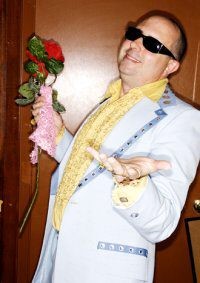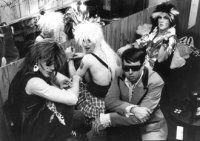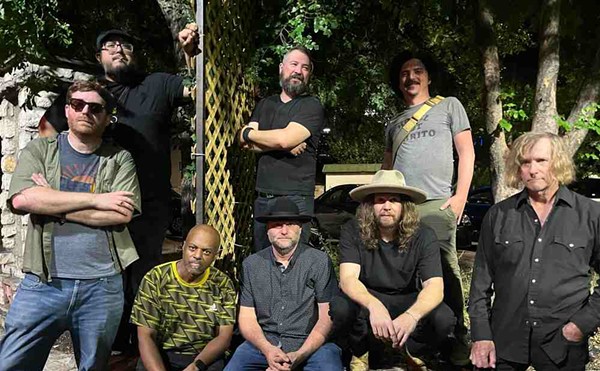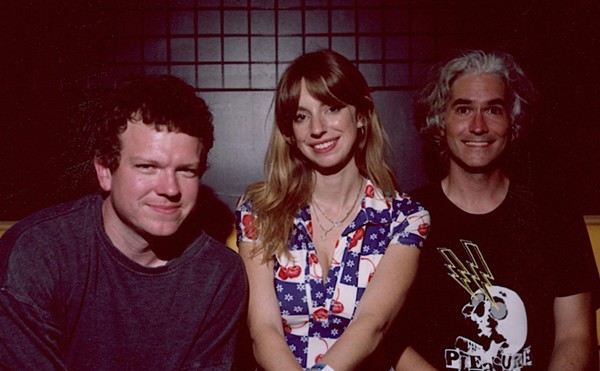|
Wayne Thomas today, above, and with Spleen (third from left) in 1989. |
Alice Cooper has often boasted that his gory early-’70s theatrics drove a stake into the heart of the peace ’n’ love generation. The former members of Spleen could just as easily argue that they did everything within their superhero powers to turn the mopey, life-sucks scowls of the grunge era upside down.
From 1989 to 1993, Spleen turned every gig into a wild dress-up party. Their stubborn insistence that they were internationally beloved rock stars, and not merely an underground San Antonio club band, earned them the rabid devotion of those who loved playing along with the fantasy. It also drew annoyance from a few local musicians who didn’t get the joke, and wondered where these guys got off with their outrageously stuck-up behavior.
What neither the admirers nor the detractors realized at the time (and, for the most part, even since then) is that Spleen was a full-blown tribute band to Jem, the ’80s animated series about a quiet young woman who ran an orphanage and was able to transform herself into a pink-haired new-wave queen who fronted a band called the Holograms. The true genius of the Spleen concept, beyond their spirited execution, was that they never let anyone know the origins of their material. By taking the electro-pop nuggets of the cartoon and placing them in a punk-rock context, they validated their premise: that the one-minute sing-along anthems on the show were better than most of what was contaminating the rock airwaves at the time.
Spleen was the brainchild of Wayne Thomas and Jeff De Cuir, two longtime friends and music-scene veterans who shared an appreciation for Jem that scared even them a bit.
“We got into Jem the way Charles Manson got into the Beatles,” jokes De Cuir, who as Spleen’s drummer became known as Stormer. “We had to look for all the codes and messages Jem and Hasbro were trying to send us. It went deeper than, ‘Oh, what a great show.’”
After putting together a limited-edition Jem fanzine, the two friends decided to form a band in the show’s image. They enlisted guitarist Brad Parks, a musical wizard who took the keyboard-dominated Jem songs (which De Cuir had diligently compiled on a two-hour video) and adapted them to guitar, and bassist Quinn “the Eskimo” Matthews, who’d spent “nine very long months” playing with the Butthole Surfers in 1982 (even receiving his nickname from Butthole Surfers singer Gibby Haynes).
Because of his transcribing skills, Parks held a great deal of power over which of the 200-plus Jem songs the band attempted. A Ramones fan, he generally gravitated toward Jem’s punkier, snottier material, such as “Gimme A Gimmick,” a song originally performed by Jem’s rival band, the Misfits.
“We tried to make Jem real in our lives,” says Thomas, the intentionally smarmy frontman known as Riot. “They all had secret identities, so we had secret identities. They were international rock ’n’ roll superstars, and we were international rock ’n’ roll superstars. They had an orphanage, so we had an orphanage.”
The Spleen “orphanage” manifested itself at shows, with Thomas inevitably announcing, “If you’re a young woman tonight and you don’t have a place to sleep, we have one for you. Talk to a member of Spleen.” Thomas recalls: “We were just very loving and caring about it.”
Jem not only represented an irresistible fantasy world for Thomas and De Cuir, it also suited their musical tastes. Unabashed connoisseurs of bubblegum pop, they loved the fact that Jem’s songs included every structural element of a great pop song (verse, chorus, middle eight, killer hook), all compressed into less than a minute, with no wasted time for solos or long introductions.
Also, with the grunge movement making self-pity fashionable, and with tons of indie bands suddenly convinced that they could attain major-label superstardom, Spleen took the opposite tack.
“Everybody wanted to get signed,” De Cuir says. “We thought, ‘We don’t need to wait for an external force to legitimize what we’re doing. If we’re going to be rock stars, it’s going to be by our own decision. We’re going to claim that it’s so, and start operating from that point on.’”
Initially, the group wore jeans and plain shirts onstage, but Parks convinced them to glam it up. They began wearing dresses and spiky wigs, which had the odd effect of making them look like a Poison parody group. Thomas was the lone wardrobe holdout, insisting that since he was the only band member without a girlfriend, he couldn’t afford to send out any confusing signals to the opposite sex. He opted for a lounge-lizard tuxedo and dark shades.
Removed from the narrative specifics of the cartoon, and placed in the context of Spleen gigs at Alfred’s or Taco Land, the Jem songs sounded like a series of bizarre non sequiturs. What were listeners to make of Thomas, yelping in a demented cowboy twang: “Come on in, the water’s fine”?
And it’s hard to think of any musical artist, with the possible exception of LL Cool J, with more recorded testaments to their own greatness than Spleen. “I Am A Giant” finds Thomas bragging: “I am 20 stories tall/ towering above it all.” And “The Spleen of Rock ’n’ Roll” (originally “The Jem of Rock ’n’ Roll”) issues this manifesto: “Listen baby, can’t you see/ you are looking at royalty/ I possess the crown/ ’cause I’m the best thing going down.”
To maintain the illusion, the members of Spleen would wear mechanics’ jumpsuits before each gig, and pretend to be their own roadies. After setting up their gear, they’d change clothes backstage and get into character. They committed to their characters so intensely that when old friends approached them after shows, they pretended not to know them, and spun false tales about touring Japan.
“You go to the movies and you pay to be manipulated,” De Cuir points out.
Spleen’s lone release was a 1990 22-song cassette which they duplicated themselves, to avoid possible legal repercussions from the creators of Jem. Only 35 copies were issued, and the tape has become a prized collectors item among SA music followers.
Matthews left the band in 1991 to devote his full attention to his other band, Petting Zoo, and the group soldiered on for two more years with new guitarists and bass players. These days, De Cuir carries on the spirit of Spleen with Hyperbubble, a synth-pop duo that features his wife Jessica on lead vocals. Hyperbubble shares Spleen’s love of artifice, with a robotic-looking De Cuir twiddling knobs behind a futuristic arsenal of sequencers and synthesizers and Jessica, in go-go boots and splashy mini-skirts, suggesting a real-life Jem.
Matthews works with local artist George Schroeder, and says he’s slowly learning to play the piano, while Thomas describes himself as “retired.”
As they look over a scrapbook of their old photos, fliers, and media clippings, they seem amazed at what they pulled off. De Cuir remembers Spleen opening for Henry Rollins at Axiom in Houston, and making the crowd of skinheads angry by calling them “sweethearts.” During the gig, the members of the group looked at each other and smirked, “We’re playing Jem songs, man!”
De Cuir says: “A lot of it was, ‘Let’s see where it can get us if we don’t tell anybody. Maybe if we slip it in that way, they won’t be so resistant to it.’”
Link to a webpage featuring all the SPLEEN recordings made from1990-1995
http://hyperbubble.net/06spleen/spleen.html


















